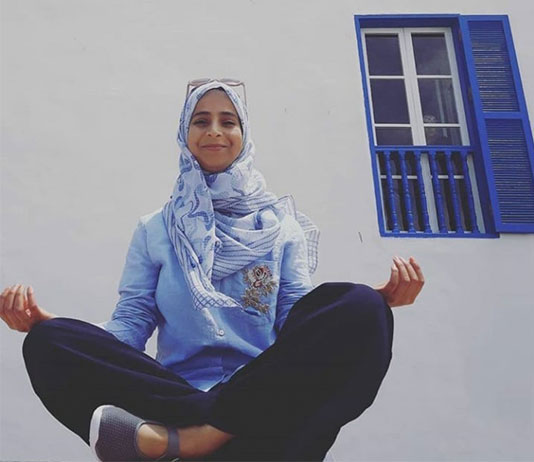This Arabic Language Day, we’re highlighting the contributions of outstanding Fulbrighters who live the Fulbright mission through sharing Arabic language and culture. In this Q&A, Fulbright Foreign Language Teaching Assistant Chama Bououd, an Arabic language FLTA at Stetson University, shares her experience teaching remotely, her tips for learning a foreign language, and what her students have learned about Morocco.
1. Tell us a little about your path to Fulbright. Who or what inspired you to apply?
Chama: My name is Chama Bououd. I am from Morocco and a native speaker of Arabic. I also speak French and English. I am interested in learning from other people and curious about other cultures. I believe that, now more than ever, we need to communicate and exchange our cultures and look from another’s perspective. I saw an opportunity in the Fulbright FLTA Program to experience American culture and share my own culture and native language, and was inspired by Fulbright’s mission to promote mutual understating of cultures and people.
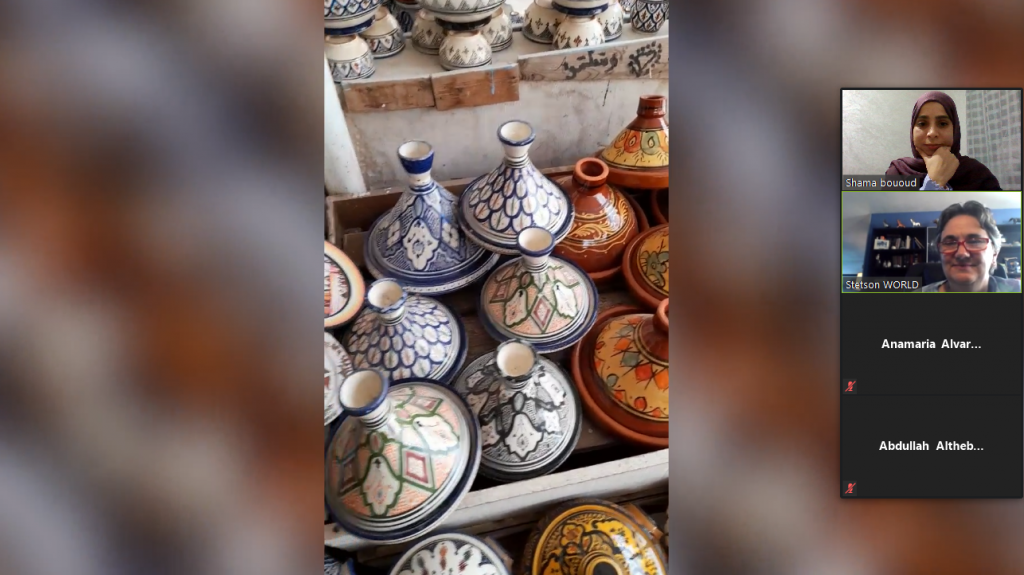
FLTA Chama Bououd introducing the Moroccan tajine, an earthenware pot and dish, to her Arabic class.
2. What tips and tricks have you learned for teaching a foreign language remotely? How have you engaged your students?
Chama: I had to teach remotely from home for the Fall 2020 semester. It was my first time studying and teaching online: teaching a language online is a bit demanding and can be challenging, but the primary instructor, my students, and I made it work. We did our best to cope with the circumstances and we succeeded. I tried to be creative during the classes, recording videos, using my hands and body language to explain and to overcome constraints. I shared Arabic culture, including funny expressions, music, videos, and through conversations, in order to engage all students, especially those beginning to study the Arabic script.
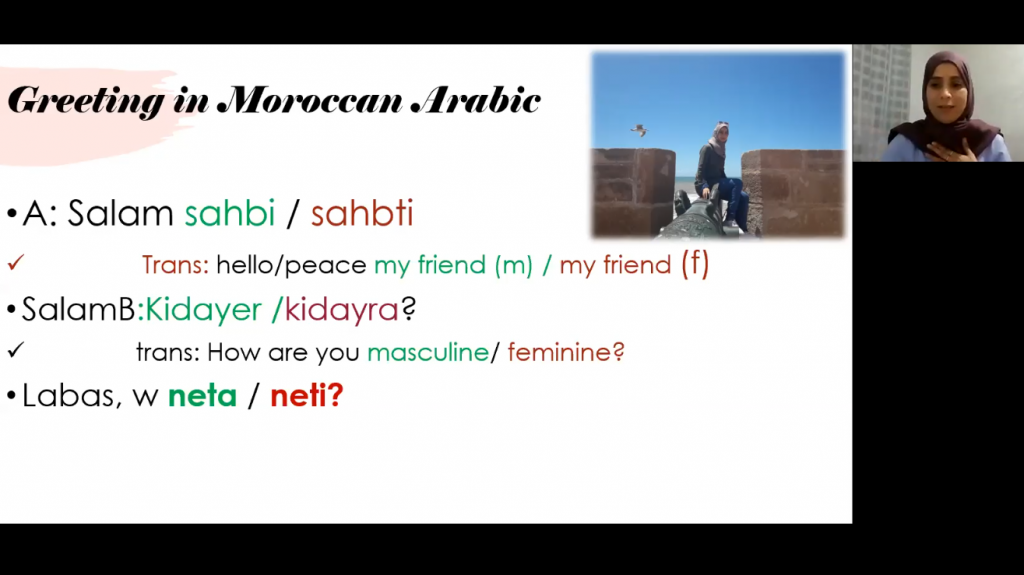
Chama teaching Arabic greetings for a beginning Stetson University Arabic language class.
3. What advice would you give to Arabic language learners, especially those learning via the internet?
Chama: For someone learning Arabic, I would recommend listening to Arabic music, watching movies, following pages that share Arabic content on social media, and watching Arabic videos on YouTube, etc. This enables learners to hear Arabic within context, and to see that Arabic exists beyond class and textbooks, especially for learners who do not live in an Arabic-speaking community. Besides, exposure to a foreign language improves learning, and no language can be learned in isolation from its culture.
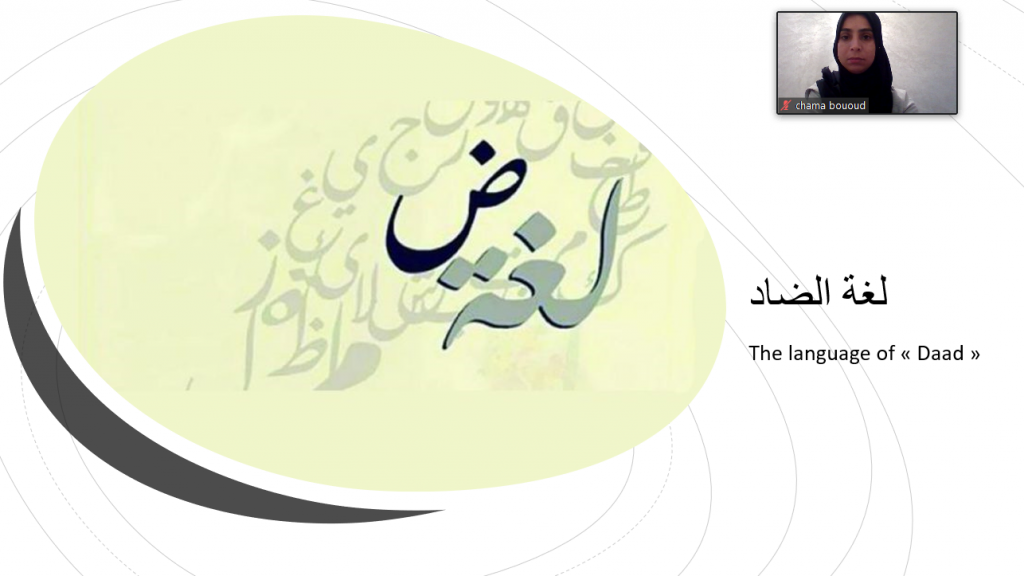
Chama introducing the Arabic letter “daad” to her Arabic class.
4. What might an American be surprised to learn about your home country?
Chama: I noticed that some of my American students and classmates thought that all Moroccan women cover their heads with a hijab, or that we were only allowed to wear black. I explained to my students about Moroccan hospitality, and they were surprised to learn that a host will keep offering guests food, and won’t take “no” for an answer. This is not to be imposing, but rather to be hospitable. I also explained that when shopping in Morocco, you must bargain: the actual price of the product might be half of what the seller is saying, because they expect the customer to bargain.
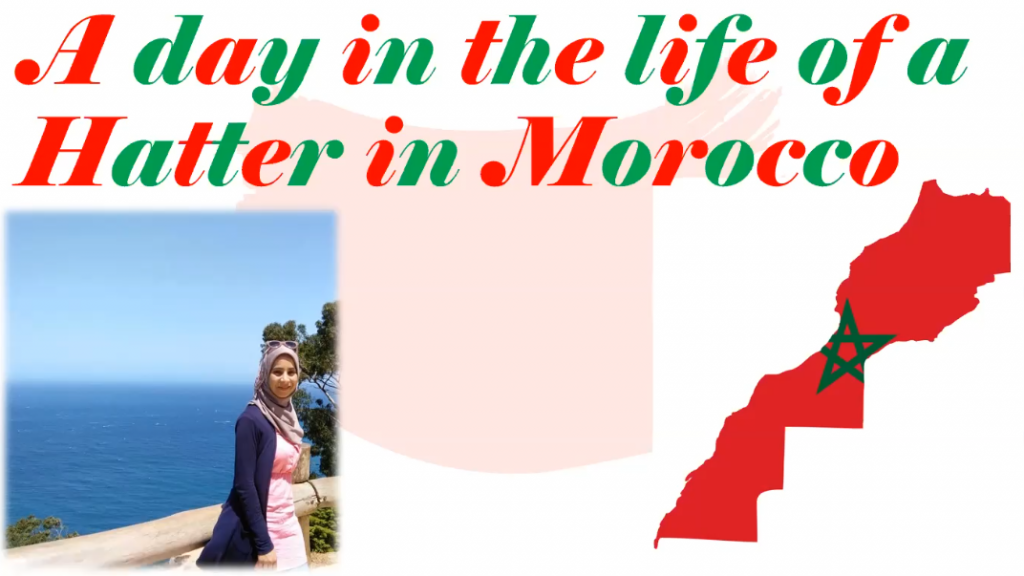
Chama’s presentation on Moroccan Hatters.
5. What is your biggest takeaway from your Fulbright Program?
Chama: My experience in the Fulbright Program has enabled me to look at the world from a different perspective. I have met so many wonderful and helpful people who have welcomed and supported me. I have made connections and learned a lot from my students and classes at Stetson University—this will definitely help me with my academic career and future plans.
Top 5 Fulbright Student Blog Posts of 2020
December 10, 2020By Jou-Chun Lai, Chinese FLTA at Michigan State University (MSU)
“我覺得我好像跟沒有出國一樣。”
I feel that I didn’t even go abroad.
A Chinese girl I met on campus uttered this phrase after I’d been at Michigan State University (MSU) as a Fulbright Foreign Language Teaching Assistant (FLTA) for a month. It’s not hard to imagine why this student made this statement: my host institute, MSU, has a large number of students from China.
The Chinese community at MSU is very close. You can join or get information from Chinese student organizations, easily find Chinese roommates, and even work in research laboratories where everyone else is Chinese. Because of this far-reaching comfort zone, even if someone in the Chinese student community wanted to practice English, it’s hard to find a way to do so.
However, I noticed that MSU also has between 130-150 students learning Chinese as a foreign language. These students might be American, Chinese-American, or from other countries. Surprisingly, only a few of them have friends who are Chinese students.
Then, an idea came to my mind: Why not build a bridge between these two groups?
This is how everything started.
First, I worked with a student club with only one member, “ForeignersLearnChinese.” We redefined the club’s goal and started to recruit a new executive board mid-semester. During recruitment, the idea of a “Chinese Language Mingle” event came together, and we began planning. The main idea of the event came from the concept of having a language exchange partner, so we invited native Chinese students to be our table leader volunteers. Each table had a conversation topic based on different Chinese speaking levels (Beginner, Intermediate, Advanced).
Participants practiced their Chinese through conversations about their family, hobbies, and other common themes. We also had some interesting conversations about the difference in dating culture between China and the United States. However, the most popular table was “Chinese Internet Slang and Abbreviations.” This is something you never learn in the classroom, but can be very practical in your daily life. If you learn some slang to use with native speakers, you’ll seem very knowledgeable and even cool.

At the end of the event was our first language partner meeting. Using a pre-survey from students learning Chinese and native Chinese speakers, we matched language pairs based on mutual majors or hobbies. After the first meeting at our event, they could hang out by themselves, choosing to practice more Chinese or English.

It was amazing to see them find their partners, start to talk in Chinese, and maybe begin new friendships. I started to imagine that as my students began to communicate with each other more, they would come to not only know more authentic Chinese, but also understand the diversity of the Chinese language. I also imagined that the native Chinese students would gain deeper insights into American culture and student life.

As a FLTA, I know that I’m just a passerby, and leaving soon. These students might forget everything I practiced with them in the textbook, but I believe having a local friend who is a native speaker is the best way to keep your motivation up and practice a foreign language. Language is not just a subject, but a medium to connect with others. Having a chance to build a bridge for my students is the most meaningful thing I’ve done during this journey.
In the beginning, I always felt disheartened reading about other Fulbrighters who always seemed brilliant and successful. It seemed like I was the only one who was lost and couldn’t find meaning and value. If you also feel the same way sometimes, just remind yourself that it’s normal.
Be patient with yourself, take a breath, observe your surroundings, and open your mind and imagination to new solutions. Everything happens for a reason and I hope hearing my story will help you find your own way.
By John Paul Obillos Dela Rosa, Tagalog Foreign Language Teaching Assistant, Northern Illinois University (Written January 2020).
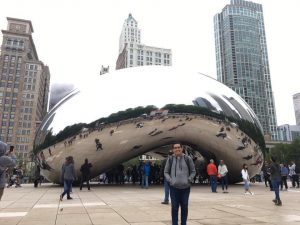
At Cloud Gate (The Bean), Millennium Park, Chicago, IL
Months have passed since I began my Fulbright Foreign Language Teaching Assistant (FLTA) journey in the United States. I still remember how my mom and I shed tears of joy when we learned that I was accepted into the Program. Before I arrived, I promised myself that I would travel and explore as much as I could, meet lots of new people, and be an enthusiastic cultural ambassador for my country. While I expected that some things would change, I did not realize that my FLTA experience would drastically impact my life, especially the way I look at the world. One important thing that I’ve learned is the value of cross-cultural communication and how intercultural competence has been nurtured by my FLTA experience.
LIVING WITH MY CO-FLTAs FROM SOUTHEAST ASIA
As an FLTA at Northern Illinois University (NIU), I live in a student dormitory on campus with four other FLTAs from Southeast Asia: Bunga (Indonesia), Su Su (Myanmar), Ildi (Indonesia) and Songwut (Thailand). While we all come from the ASEAN region, we are very different from one another. From how to correctly pronounce the names of our countries, individual food preferences, families and personal life–each of us has our own beliefs and aspirations that are mostly dictated by our cultures. The experience of living with other FLTAs has given me a deeper understanding of cross-cultural communication that reading in a book alone could not provide. The five of us get along really well. Funny as it may seem, we share one common interest: we always enjoy taking photos when there is snow! This has been an exciting activity for us FLTAs at NIU, seeing snow and experiencing winter for the first time!
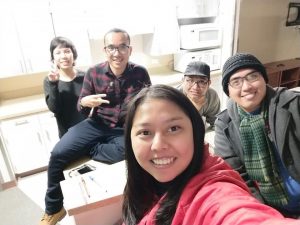
My FLTA colleagues from Southeast Asia— Su Su (Burmese), Thor (Thai), Bunga and Ildi (Indonesian)

My Indonesian FLTA friend and I , Ildi, are enjoying the pristine white view of DeKalb, IL on New Year’s Eve.
IMMERSING MYSELF INTO A NEW CLASSROOM ENVIRONMENT AND WORKPLACE
At NIU, the classroom culture and workplace environment are different in comparison to the Philippines. The concept of personal space in American culture is also essential to understand. I consider myself a big “hugger” just like many other Filipinos, but with my current students, I had to learn how to respect their personal space.
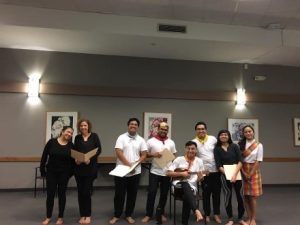
Our Beginning Tagalog students serenading the audience with a nostalgic Tagalog song during the Southeast Asia Cultural Night at Northern Illinois University (NIU) back in October.
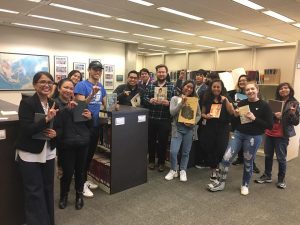
Exploring the Southeast Asia Collection of Founder’s Memorial Library at NIU with my supervisor, Prof. Rhodalyne Gallo-Crail, and our Tagalog students.
Workplace culture is different in the United States, too. Having an open mind matters, and criticisms are not always negative; they are meant to help improve ourselves. I learned that I do not have to go around in circles and worry too much if I’m unable to say “yes” to an offer or a favor asked. I have always been very circular in terms of how I communicate with people, but here in the United States, I learned how to be more direct in the workplace. Punctuality is of prime importance in American culture., as well. Respecting time is respecting other people’s time.
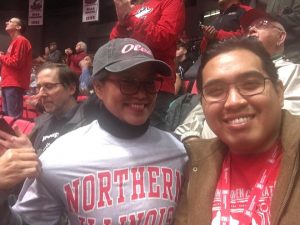
Working with my supervisor at NIU is a great learning experience. I consider her the coolest and smartest mentor I’ve ever had. She is no less than Prof. Rhodalyne Gallo-Crail, my Ate Rhoda.
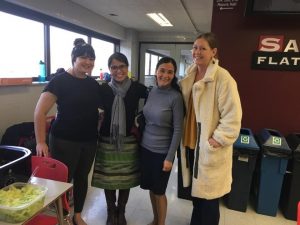
A photo opportunity with the kind-hearted employees of Northern Illinois University. I am fortunate to have been hosted by a caring and nurturing academic community!
CONNECTING TO THE REST OF THE COMMUNITY
Another exciting aspect of being an FLTA is connecting with my host community—lending a helping hand, spreading positivity, and sharing my language and culture. I was able to meet Americans from all walks of life, with different professions, old and young. They all have their own opinions about things. Some are the same as mine, some are not, but what I learned deeply is the value of listening to other people and respecting them, no matter what their opinions are. That is one important aspect of becoming an interculturally competent individual. We need to meet halfway, with open minds and hearts.
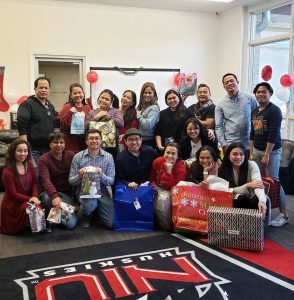
Striking a Yuletide pose with my second family in DeKalb, Illinois—the Kishwaukee Filipino-American Community.
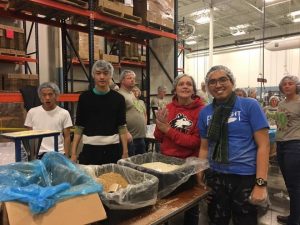
It was a fulfilling experience to be part of “Feed My Starving Children,” a non-profit organization that provides free and healthy meals to the many starving children around the world.
I am also sharing this one, big community of mine with my colleagues from the FLTA Program. The thought that one has friends from all over the world who share the same passions and interests is always exciting! I have met and made friends with other FLTAs from Egypt, Spain, Argentina, France, Taiwan, Japan, Pakistan, and other parts of the world. We still exchange teaching strategies and share our great adventures across the United States. Two of the most memorable encounters I have had in the United States were our Summer Orientation at The University of Arizona, and of course, the FLTA Midyear Conference in Washington, D.C.
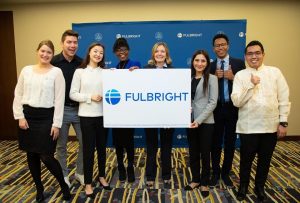
A rare opportunity to be photographed with Assistant Secretary of State for the Bureau of Educational and Cultural Affairs (ECA), Marie Royce, and other FLTAs who are constantly involving themselves in different community outreach activities.
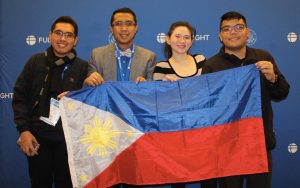
The happiness felt to represent one’s country as an FLTA is incomparable. I share the same feeling with other Filipino FLTAs who were with me during the 2019 FLTA Midyear Conference in Washington, D.C.
We only have few days left before we say goodbye to our host institutions. I hope my co-FLTAs have also found ways on how to nurture their intercultural competence. May we all replace judgment with curiosity and let cultural understanding reign on this beautiful FLTA journey!

“Working as a team to try to find a solution to this problem” – 2015 Fulbright U.S.-France Fulbright-Tocqueville Distinguished Chair and U.S. Scholar alumnus Dr. Benjamin J. tenOever continues to collaborate internationally with Marco Vignuzzi’s laboratory at the Institut Pasteur to test FDA-approved drugs in order to treat COVID-19 symptoms.
For more than 70 years, the Fulbright model of living and learning together with people of different cultures has helped forge lasting connections worldwide and has brought people and nations together to work toward common goals. This mission is more vital today than ever, and we thank the Fulbright community—participants, alumni, advisers, university and host partners, and staff at Fulbright commissions, embassies, implementing partners, and more—for coming together to take on today’s unprecedented challenges.

Malaysia ETA alumna Rachel Jacoby stays connected with her cohort, which supports their local communities across the United States through Feeding the Frontline, an organization that raises money and delivers meals to medical staff and workers fighting COVID-19.
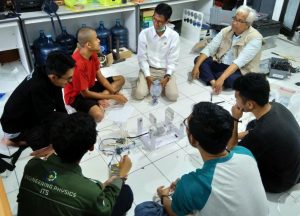
Looking for innovative ways to create medical supplies, Fulbright Visiting Scholar Dr. Aulia Nasution, with students and colleagues of Sepuluh Nopember Institute of Technology (ITS) Department of Engineering Physics, made a prototype of a low-cost ventilator using an open-sourced Massachusetts Institute of Technology (MIT) design.
We express our gratitude to Fulbright participants and alumni engaged in the fight against the Novel Coronavirus (COVID-19). Fulbrighters are healthcare workers, scientists, inventors, policy makers, journalists, academics, entrepreneurs, teachers, and professionals of all backgrounds. Fulbrighters are leaders, innovators, experts, and trailblazers. Fulbrighters are creative, compassionate, resilient, and generous. Fulbrighters are simply extraordinary, and we are so proud of the many ways they are taking action.
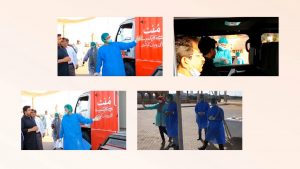
As Pakistan combats the COVID-19 pandemic, alumni Dr. Muhammad Moiz and Rana Muhammad Umer helped establish the country’s first drive-through testing facility in Karachi.
As we look forward to the future, we will begin posting stories from our Fulbright alumni, written prior to COVID-19. We hope they will continue to inspire and educate as we navigate the future together.

